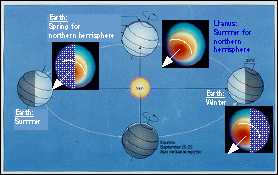This is an image of Uranus and Earth showing their seasons.
Click on image for full size
Image from: The Atmosphere, 5th edition
A Uranus day = a Uranus summer
As a planet orbits the sun, if its rotation axis is tilted, the portion that is tilted toward the sun will receive an excess of sunlight and energy (summer), while the hemisphere which is tilted away from the sun will be deprived of sunlight and energy (winter). Half a year later, the hemisphere which receives the most sun will be reversed. The fact that there may be an excess or a deficit of light and energy affects planetary meteorology.
Because Uranus lies on its side, with the north pole facing the sun, Uranus' seasons should be very strange. The north pole faces the sun, which means it is in daylight, and the atmosphere in that hemisphere never rotates to the nightside to cool. The south pole faces away from the sun, and the atmosphere in that hemisphere never rotates to the day. As Uranus orbits the sun, the north pole will be in daylight for half of a year (spring and summer). This means a Uranus day is the same as a Uranus summer. The meteorology of such a planet should be very strange.
You might also be interested in:
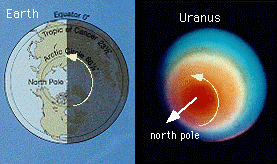
In this picture, the view of the north poles of the Earth and Uranus are shown together. In the view of the Earth, the sun is shining from the left, and part of the north pole is in daylight and part of
...more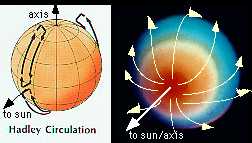
In general, the weather on earth can be described in the following way: in response to incoming energy from the sun, the air rises at the equator and drifts to the poles where it is colder. Because Uranus
...more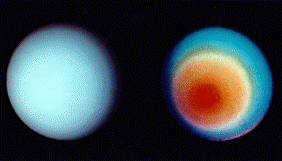
The clouds of Uranus, composed of methane crystals, are found very low in the troposphere, and are difficult to distinquish below the smog haz es of the planet's atmosphere. False color is used, in the
...more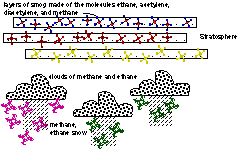
Besides methane, Uranus' atmosphere contains more sophisticated atmospheric molecules such as ethane gas, acetylene, and diacetylene. All these molecules form layers of haze at different altitudes high
...more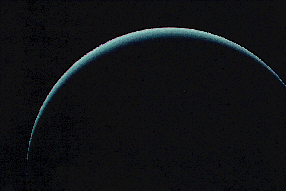
The mesosphere of Uranus is a region of balance between warming and cooling. That essentially means that nothing happens there. Except for diffusion, the atmosphere is still. Upper reaches of the atmosphere,
...more
As on Earth, the atmosphere of Uranus consists of a troposphere, stratosphere, mesosphere, and thermosphere. The troposphere is the region where the visible clouds are to be found. The stratosphere, as
...more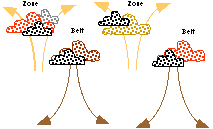
On Uranus, as on Jupiter, the winds in the belts and zones blow first in one direction, then in the opposite direction. Wind blows east in a belt, and west in a zone. The clouds rise up in a belt, and
...more


